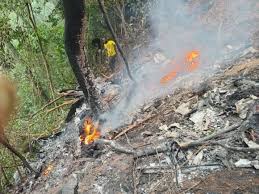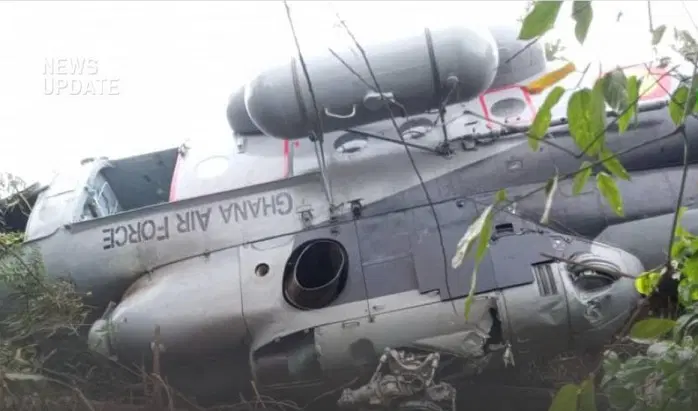The recent helicopter crash involving eight public officials continues to dominate national conversation, with aviation experts and policy analysts questioning the flight protocols that governed the journey.
Bright Simons of IMANI Africa has weighed in on the matter, reacting to findings by security policy researcher Colonel Festus Aboagye (rtd), which revealed that the aircraft was cleared to fly under Special Visual Flight Rules (VFR).
This revelation has opened up a critical debate about the decision-making process surrounding the clearance of high-value missions in Ghana.
According to Simons, flying under VFR essentially meant that the pilot was expected to rely heavily on visual cues during the journey from Accra to Obuasi.
Unlike Instrument Flight Rules (IFR), which demand navigation based on advanced equipment, VFR requires the pilot to depend primarily on sight and environmental awareness, supplemented by minimal reliance on flight instruments.

“The typical instrument set for IFR includes IFR-approved two-way communication radios, geolocation sensors like GPS & TACAN, turn-rate and slip/skid indicators, baro-settable altimeters, etc. Landing is based on a pre-cleared ‘instrument approach’ and published ‘path authority’.”
Bright Simons
He further explained that under IFR, air traffic controllers maintain a much firmer grip on navigation and landing operations than under VFR. This includes ensuring obstacle clearance and managing anti-collision protocols.
Importantly, IFR requires both the aircraft and its pilot to be certified, with the right equipment on board and the pilot having undergone specialized training and evaluation.
Weather And Terrain Concerns
Bright Simons further noted that in practice, even skilled pilots flying under IFR still use visual cues for situational awareness, but official shifts between protocols are usually authorized by air traffic control or mission command. In this case, the reliance on VFR raised several red flags.
First, if the helicopter was cleared for VFR, then suggestions that poor weather and visibility along major portions of the route contributed to the crash appear inconsistent.
Normally, mission control would not clear a helicopter under VFR conditions if weather forecasts were anything less than extremely favorable.
Second, the idea that the terrain along the critical segments of the flight path was considered too challenging also seems difficult to reconcile.

As Simons emphasized, “controlled flight into terrain risks are pronounced under VFR, so why would that choice be made by the task schedulers?”
Third, the fact that this was a VIP transport mission makes the choice of VFR even more unusual.
“As this was a VIP transport mission, clearance for VFR can only suggest extreme comfort with all the relevant parameters. Deviations from that expectation would thus have triggered faster emergency response.”
Bright Simons
He added that although the loss of radar contact is an issue of airspace rather than flight rules, it would have accelerated the need for mission control to initiate emergency procedures once it became clear the flight was operating under VFR conditions.
Policy Questions Raised After Helicopter Crash
Simons disclosed that, based on ongoing research and consultations with aviation specialists, decision-making parameters for choosing VFR in missions of such magnitude have been documented.
These findings point to deeper policy considerations about whether IFR should always be the default protocol for transporting VIPs and VVIPs in Ghana.

He explained that “whilst the loss of radar contact is an airspace rather than flight-rules issue per se, it would have contributed to faster IMIC mode-shifting given the VFR choice.”
The broader issue, according to him, is whether Ghana currently has robust enough systems to ensure that high-level government missions are conducted under the safest and most reliable flight protocols available.
He also noted that the rough consensus among aviation specialists surveyed so far is that the government must urgently clarify whether IFR will become the standard protocol in such cases.
Interim Measures Still Unclear
For Simons, the tragedy highlights gaps in Ghana’s aviation policy framework that must be addressed without delay.
He questioned whether any interim measures had been put in place while investigations into the helicopter crash continue.
“These findings prompt questions about any interim policy measures taken so far: a) has the government grounded all military air transport for VIPs and VVIPs whilst investigations continue? b) Has a default choice between IFR & VFR been made?”
Bright Simons

These questions remain unanswered for now, but they touch on matters that will likely shape public confidence in the country’s aviation safety going forward.
With the loss of lives and the high-profile nature of the crash, many Ghanaians are demanding transparency and accountability in the decision-making process that permitted the mission to go ahead under VFR.
As the nation waits for further findings from investigators, the debate sparked by Simons underscores a pressing need for reforms.
If anything, the tragedy has revealed how critical it is for Ghana to reassess its aviation protocols, particularly for missions involving top government officials.
The decisions made in the coming weeks could reshape not only how the military and aviation authorities operate but also how the public perceives the safety of VIP air transport in the country.
READ ALSO: Ghana Pushes Mining Reforms as Minerals Commission Outlines Overhaul of Act 703


















